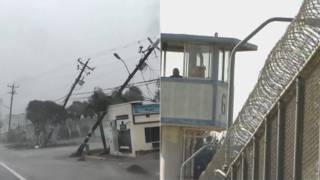
Related
As millions of Florida residents in the path of Hurricane Ian were ordered to evacuate, advocates pushed authorities to also evacuate what they say are as many as 176,000 people incarcerated in prisons, jails and immigrant detention centers. Now the storm has left millions without power and many without water. “We’re worried about the conditions in the days and weeks following, with no AC, lack of sanitation and water, lack of food, lack of appropriate staff and access to health,” says Angel D’Angelo, a member of Restorative Justice Coalition and Fight Toxic Prisons.
Transcript
AMY GOODMAN: This is Democracy Now!, democracynow.org. I’m Amy Goodman, with Nermeen Shaikh.
As millions of Florida residents in the path of Hurricane Ian were ordered to evacuate, advocates pushed authorities also evacuate of over what they say are as many as 176,000 prisoners. That’s right, people incarcerated in prisons, jails, immigrant detention centers. Some prisoners saw their units evacuated. Others were put on lockdown with minimal staff. The Lee County Sheriff’s Office said they declined to evacuate people from the 457-bed Fort Myers Jail, even though the county map shows the jail is in the mandatory evacuation zone. This morning on Good Morning America, the Lee County sheriff confirmed fatalities were in the hundreds in the region.
When Hurricane Ida devastated southern Louisiana last year, many people were in prisons and jails that did not evacuate. In the weeks following the storm, they faced limited access to drinking water, food, electricity and medicine. Many also remember how people held in the Orleans Parish Prison, after Hurricane Katrina struck New Orleans in 2005, were deserted in their locked cells as sewage-tainted water rose up to their chests.
For more, we’re joined in Tampa by Angel D’Angelo. He is with the Restorative Justice Coalition, as well as the Campaign to Fight Toxic Prisons.
Welcome to Democracy Now!, Angel. Just tell us what you’ve learned, I mean, and this latest news out of Lee County, that they refused to evacuate the jail, even though it was in the evacuation zone.
ANGEL D’ANGELO: Good morning, and thank you for having us here.
We’re very, very concerned about the conditions in Lee County, as well as throughout the entire zone of where Ian has landed. We haven’t gotten full updates on the status of people who are incarcerated, but we know from — as you mentioned earlier, from past incidences that jails, prisons, immigration centers and juvenile halls can be dangerous places during storms, especially with long-term power outages. So, it’s not just the windfall we’re worried about. We’re worried about the conditions in the days and weeks following, with no AC, lack of sanitation and water, lack of food, lack of appropriate staff and access to health.
NERMEEN SHAIKH: And yesterday, Angel, the Florida Department of Corrections issued a press release outlining some of the safety measures they’ve put in place, saying approximately 2,500 inmates had been evacuated. Could you, please, put that in context, how many inmates there are in Florida — we mentioned a little in our introduction — in prisons, in jails and in detention centers? Two thousand five hundred have been evacuated.
ANGEL D’ANGELO: I don’t know the number offhand, including all of the jails, prisons, federal jails, state levels, juvenile centers and in immigration centers, but I know that Florida is a large state as far as our mass incarceration. The United States, of course, being the holder of 25% of inmates in the world, Florida being one of the top in the United States, so the amount that they’ve evacuated certainly doesn’t scratch the surface.
I know there’s been some evacuations. For example, in Hillsborough County, Florida, we have two jails. And thanks to the Campaign to Fight Toxic Prisons, they evacuated individuals from Orient Road Jail and moved them to Falkenburg Jail, which at least is not in an evacuation zone. So, that’s one example of an evacuation that did happen, completely, to removing all inmates from that jail to prioritize their safety. And we’re not sure why Lee County and Charlotte County, who were in danger zones, did not take those actions.
AMY GOODMAN: So, talk about what authorities say when you demand that these prisons be evacuated. Where do they get evacuated to?
ANGEL D’ANGELO: Absolutely. So, in Charlotte County, for example, a member of Fight Toxic Prisons contacted Charlotte County Jail, as one example, and was told that the jail itself serves as a shelter and that the building is sturdy. And we hear “the building is sturdy” as quite a common line from prison and jail authorities.
And whether or not that’s true — I mean, it may even be true — it’s not just the windfall that we’re worried about, or the sturdiness of the building, but rather the after-effects for a group of forgotten people who really no one’s checking on. We’ve heard stories of flooding, for example, during Hurricane Michael in 2018. Florida prisons in the Panhandle had roof damage, floods, shortages of staff and access to healthcare. So it’s not just about what’s happening during the windfall, but the days and sometimes weeks after the storm. So, the authorities also, on top of that, to consider — the authorities are also considering risking the lives of their own paid staff, as well as the people who are forced to stay there during incarceration.
AMY GOODMAN: Just to give some numbers, Florida has the third greatest number of prisoners. California is — Texas is number one, with close to 136,000. California is two, with more than 97,000 prisoners. And Florida is number three, with over 81,000 prisoners. And this is from 2020. As you say, the issues are also issues like contamination of water and everything inside the prisons. Are you speaking to people inside? Do you have access? One of the biggest problems now is people having access, let alone prisoners having access to outside world at a time like this.
ANGEL D’ANGELO: Yes, actually, that is a huge concern, obviously, around the clock, but especially during an emergency. A member of Fight Toxic Prisons did speak with someone who was incarcerated who had some concerns. I also can tell you that I spoke personally with someone in Pasco County Jail. Pasco is not necessarily in a serious threat area, but, of course, all of Florida was under a state of emergency.
My friend in Pasco County Jail has been subject to abuse for the last several weeks and forced into solitary confinement for unrelated reasons, finally was able to call me after two weeks of no contact, and barely even seemed aware that there was a storm, certainly was not aware of the intensity of the storm. When I asked questions about, you know, of course, his situation in general, I had to throw in about the storm. And he said that he felt that the building was safe as far as the exterior, but he identified to me that he has not heard about any extra safety protocols, and even said to me that a correctional office told him, “We don’t care about y’all in here.”
AMY GOODMAN: Well, Angel D’Angelo, we thank you for bringing attention to this very critical issue, and we will continue to cover it. Angel is with the Restorative Justice Coalition, as well as the Fight Toxic Prisons group. He’s speaking to us from Tampa, Florida.
Next up, as Russia announces it’s formally going to annex four occupied areas of Ukraine, we’ll speak to a prominent Ukrainian journalist who’s just back from an area that has just been retaken by Ukraine, investigating potential war crimes. Stay with us.
[break]
AMY GOODMAN: “Fantastic Voyage” by Coolio. The 59-year-old Grammy-winning rapper died on Wednesday.












Media Options